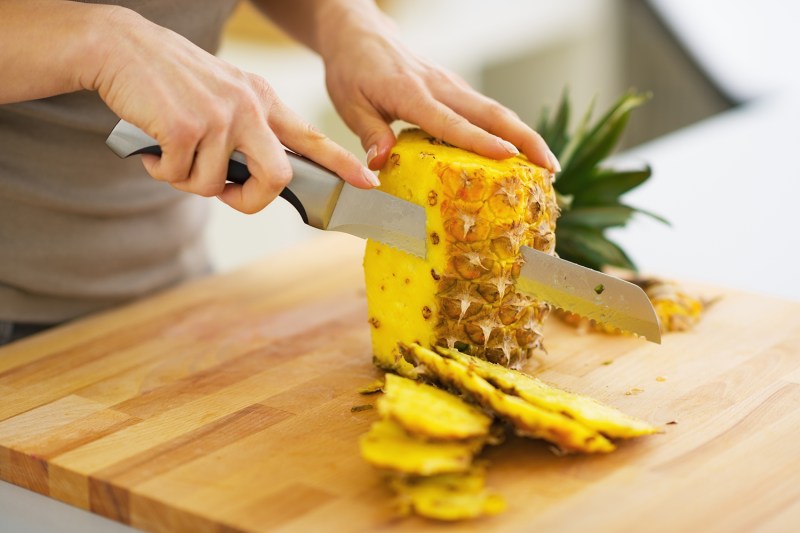 Fresh pineapple is a delicacy that is absolutely worth the effort. While its tough, knobby exterior can also look intimidating, getting to the juicy goodness inside is easier than you’d expect. Here are a few steps to help you dicing that fresh pineapple, so you can sip your Piña Colada without slicing off a finger.
Fresh pineapple is a delicacy that is absolutely worth the effort. While its tough, knobby exterior can also look intimidating, getting to the juicy goodness inside is easier than you’d expect. Here are a few steps to help you dicing that fresh pineapple, so you can sip your Piña Colada without slicing off a finger.
Related Guides
How to cut a pineapple
When shopping for pineapple, the fresher the better. You want to look for one that has a firm, brown skin with green leaves and that strong, fresh pineapple smell.
Cutting a pineapple involves strategy. There’s a specific order to each cut to make the most of your pineapple.
- Cut off the top and bottom of the pineapple. You want a level surface to begin.
- Turn it upright and place your knife at one edge.
- Find the “eyes” at the edge, brown nodes that run in rings throughout the fruit.
- Make your first slice from the top of the fruit to the bottom, removing the section of skin as close to the eye as possible.
- Continue onto the next section, carving an octagon-like shape into the fruit.
- Stay as close to the eyes as possible so you preserve as much fruit as you can.
- Once the skin is gone, slice the pineapple from top to bottom into four sections. Think about how you’d cut an apple or an orange into slices.
- Remove the interior “point” of the pineapple to remove the core. You can feel the difference in texture from the fibrous interior to the soft exterior.
- Continue cutting the wedges until you have pineapple pieces suitable for you.
Tips to cut pineapple with a knife
Cut in the right direction: You want to cut up and down with pineapples — aside from the beginning top and bottom cut. You’ll save the most pineapple and cut the fruit more safely than you would trying to cut directly through the middle.
Use the right knife: Use a very sharp knife with a smooth edge. Medium size is best, but choose based on the overall size of your pineapple. Avoid gimmicky tools or other methods because they often aren’t as efficient and end up taking forever. All you need is a clean, sharp knife and the right cutting order.
How do you cut pineapple without waste?
Using the method above allows you to remove as much of the skin while leaving the fruit behind. Stay close to the eyes of the pineapple to preserve the fruit. Your initial cut will be the largest. After that one, cut only small strips until you’ve revealed the entire pineapple.
Bonus! Keep the top and you might be able to grow an entirely new plant. Just put the top in some water, change the water daily, and wait for roots to appear.
Can you peel a pineapple?
Unfortunately, you can’t peel a pineapple — not really. The skin of the pineapple is too tough to peel traditionally. You can separate the sections of pineapple without a knife by removing the top and gently massaging the pineapple body to loosen sections.
Start from the top and begin pulling sections away, using the nodes on the outside as guides. Keep massaging to loosen the sections and remove them one by one.



